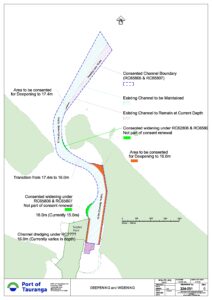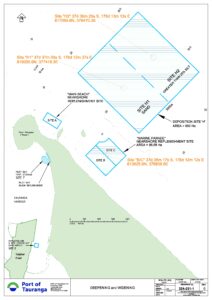Port of Tauranga is committed to protecting and enhancing the wellbeing of Te Awanui Tauranga Harbour. As part of its operations, Port of Tauranga needs to dredge the existing shipping channels and does this in a way to avoid, minimise or mitigate any impact on the environment.
Port of Tauranga wishes to renew the resource consents granted in March 2013 that are due to expire in June 2027. This page provides background information on the renewal application as well as updates on the consent process.
Background
Port of Tauranga completed Stage 1 of the capital dredging to deepen and widen the shipping channels in 2016. This allowed deeper draught vessels to safely navigate the shipping channel. The Port only dredged the amount required to meet shipping demands at the time, to minimise the amount of dredging. The second stage of the capital dredging will be undertaken from late 2025. This will allow larger container vessels that are currently restricted to high tide to transit at both low and high tide.
The Port also routinely carries out maintenance dredging every year to ensure there is a safe amount of clearance under the keel of vessels transiting the harbour.
Port of Tauranga needs to renew the resource consent issued in 2013 so that ships can continue to safely use the existing shipping channels.
How much dredging is required?
Deepening
The existing consent allows the Port to dredge to 16.0 metres below chart datum inside the harbour, and 17.4 metres below chart datum outside the harbour. Stage 1 of the capital dredging (completed in 2016) deepened the channel to 14.5 metres inside the harbour and 15.8 metres below chart datum outside the harbour. Stage 2, due to commence in 2025, will complete the deepening in the main shipping channel. The Port is applying to dredge the existing basins alongside the wharves, as well as the approach to berth 1, both of which will only be required once the respective wharves are upgraded or replaced. 
An additional area of deepening, of approximately 2,786 sqm, will also be included in the application. This work is in the existing passing lane of the entrance channel, and will effectively widen the channel by 19 metres. The purpose of this modification is to smooth the corner and enhance navigational safety.
Widening
The existing consent allows us to create a swinging or turning basin off the northern end of Sulphur Point (adjacent to the Port's container terminal) and this will be completed in stage 2 of the capital dredging due to commence in 2025. The swinging basin will give the space required to safely turn a large container vessel when there is already a vessel on the northernmost berth of the terminal. We have reviewed the size of the swinging basin and have reduced it in width by 93 metres compared with the existing consent.
Volume of material to be dredged and deposited offshore
The existing consent allows up to 15 million cubic metres of capital dredging to be deposited in the dredging grounds. In stage 1, we dredged and deposited approximately 6 million cubic metres of material. Stage 2 is expected to involve a similar quantity. To complete the remaining required dredging, we need to dredge and deposit the balance of 2.5 million cubic metres.
Maintenance dredging
Most ports require maintenance dredging and, without regular dredging, the shipping channel would infill and become shallower. Port of Tauranga wishes to continue its current level of maintenance dredging. The existing consents allow up to 185,000 cubic metres to be dredged on average every year. However, increases in storm activity due to climate change mean that more dredging is required to maintain the shipping channels. Therefore, the Port wishes to increase the allowable annual volume to 250,000 cubic metres. Although the current average is below the consent limits, in 2024 and 2025 we experienced significant infill, challenging the 185,000 cubic metres limit in order to clear the channel.
Deposition grounds
 The existing consent includes multiple sites for the deposition of dredged material.
The existing consent includes multiple sites for the deposition of dredged material.
Offshore
The existing offshore deposition ground is in water 20 to 30 metres deep. It is divided into two sections - the deeper half is used for more silty material, while the shallower half is used for sandy material. The site has been used since the 1970s and expanded several times to now encompass 900 hectares. The Port wishes to retain the existing site.
Nearshore
The nearshore deposition sites are used for premium, clean sand dredged from the harbour entrance channel. The material is rapidly dispersed under natural wave and swell action. This natural process keeps the sand dune system healthy and provides a buffer from erosion. Dredged sand is also brought ashore and stored in stockpiles where it can be used to replenish harbour beaches, such as Pilot Bay.
Questions and Answers
Will the consent renewal include the dredging of Tanea Shelf?
The existing consent allows the deepening and widening of Tanea Shelf, which extends from the base of Mauao (under water). Since we purchased our tug boats Tai Timu and Tai Pari, they can assist the large 347 metre container vessels to safety transit the shipping channel without the need to smooth the S-bend by widening the channel at Tanea Shelf. The channel in this area will be deepened only, as part of stage 2 of capital dredging commencing in 2025.
Why is the Port carrying out stage two of the capital dredging already?
The largest vessel currently visiting Tauranga are 347 metres long, 42.92 metres wide, and have a draught (depth below water) of 14.5 metres. These large vessels can only sail at high tide as the existing shipping channel is only 14.5 metres below chart datum (essentially the lowest astronomical tide). Vessels have to wait up to 12 hours if they miss their tidal window, which is not efficient and adds to the number of vessels waiting at anchor. Completion of stage 2 will alleviate some of the congestion at the container terminal.
Find out more
More information will be added here once it becomes available.
Please email any questions to: [email protected]